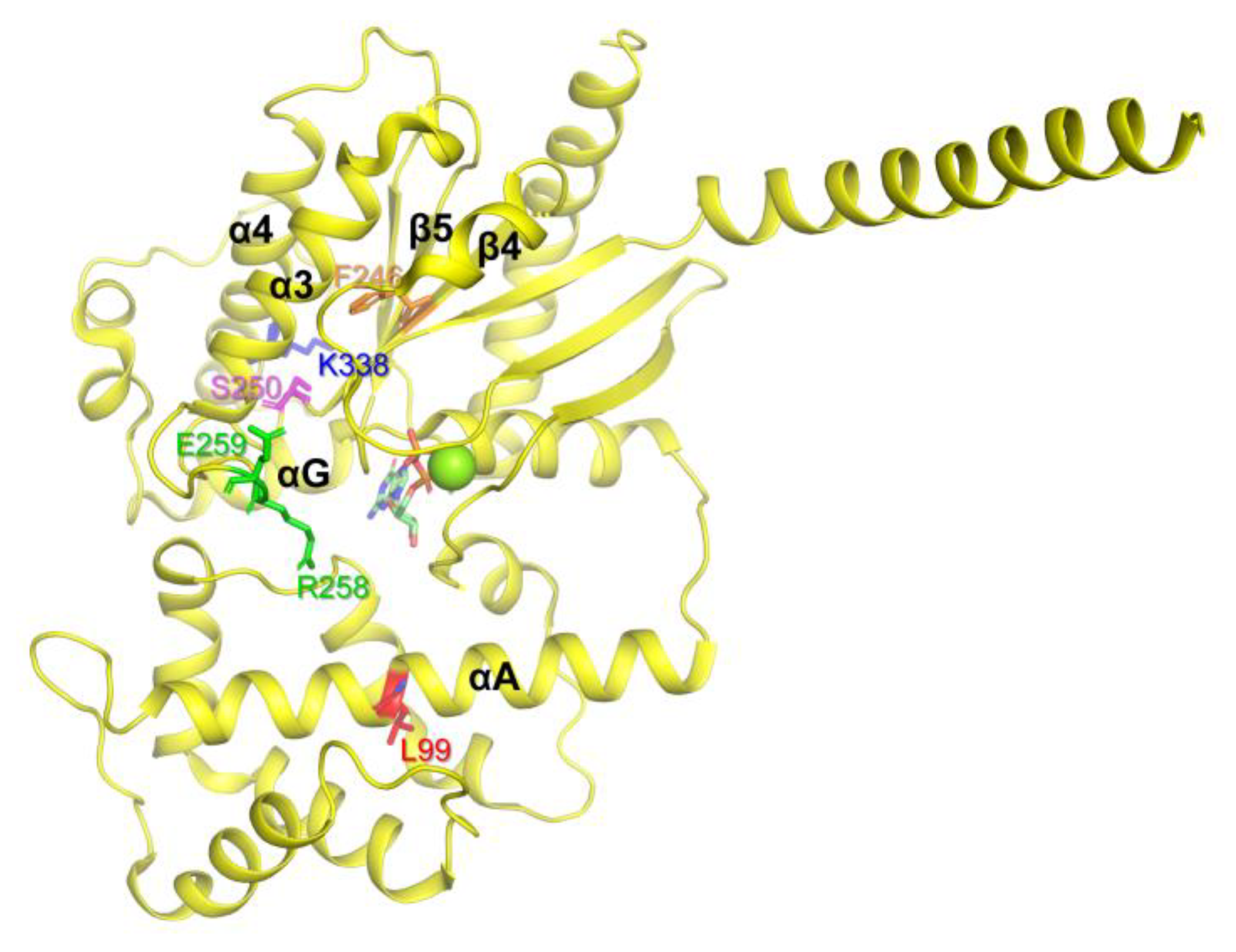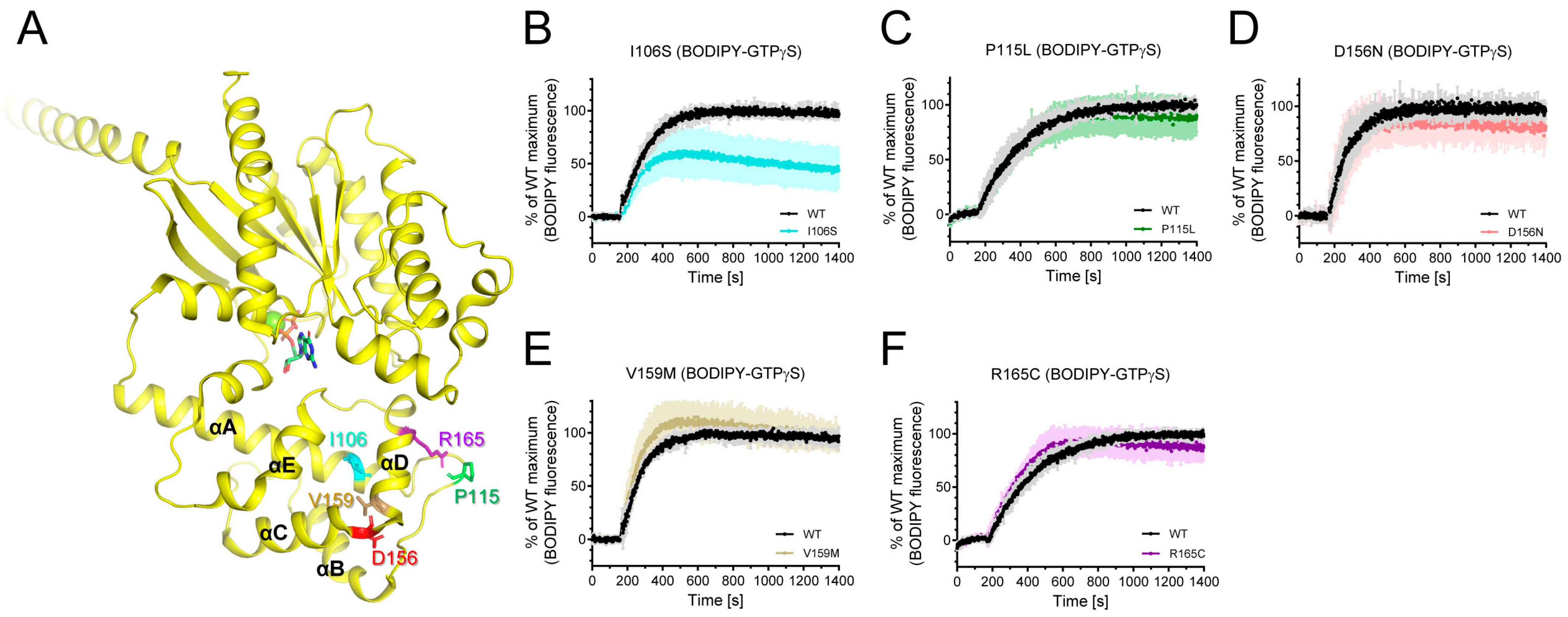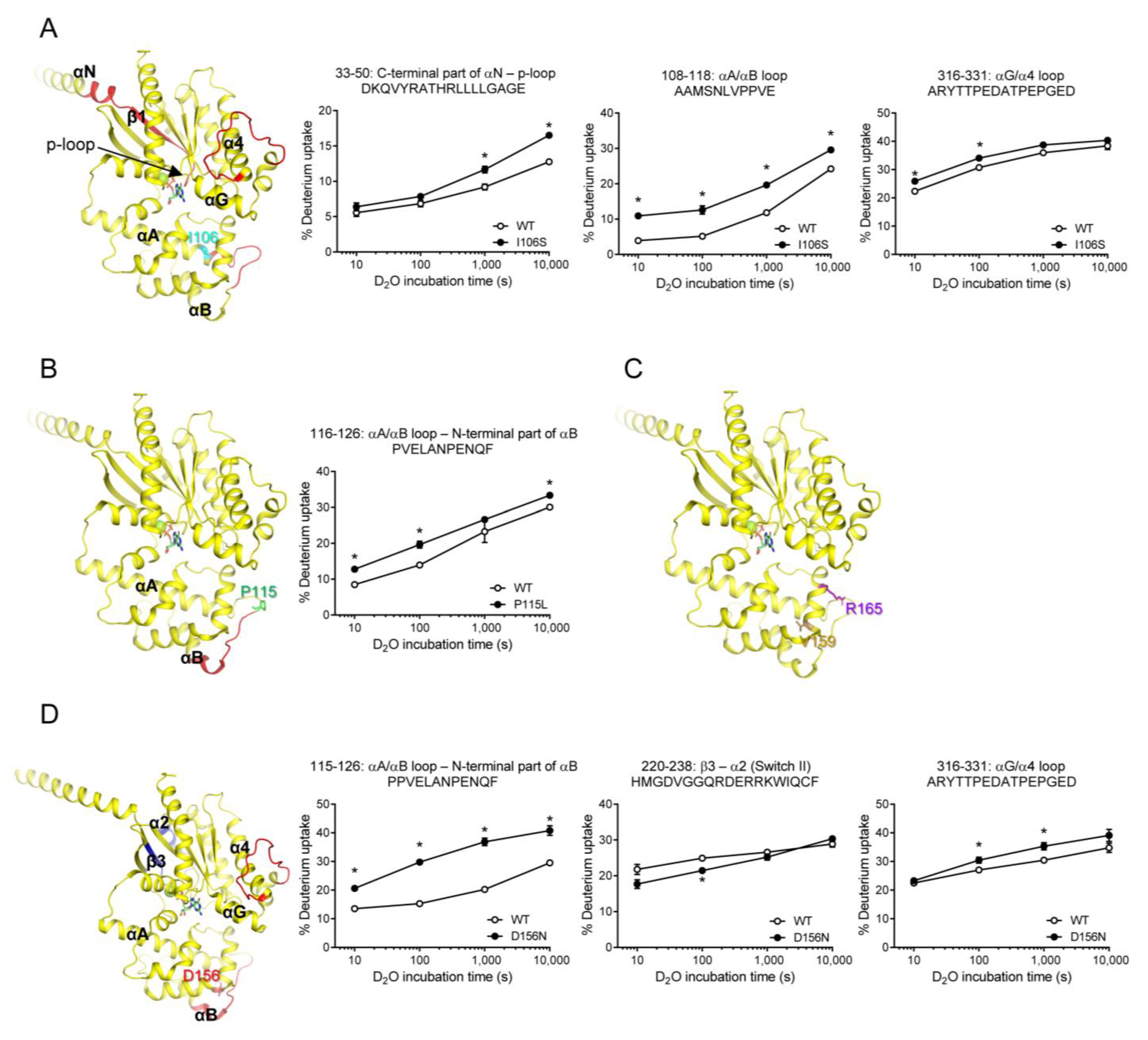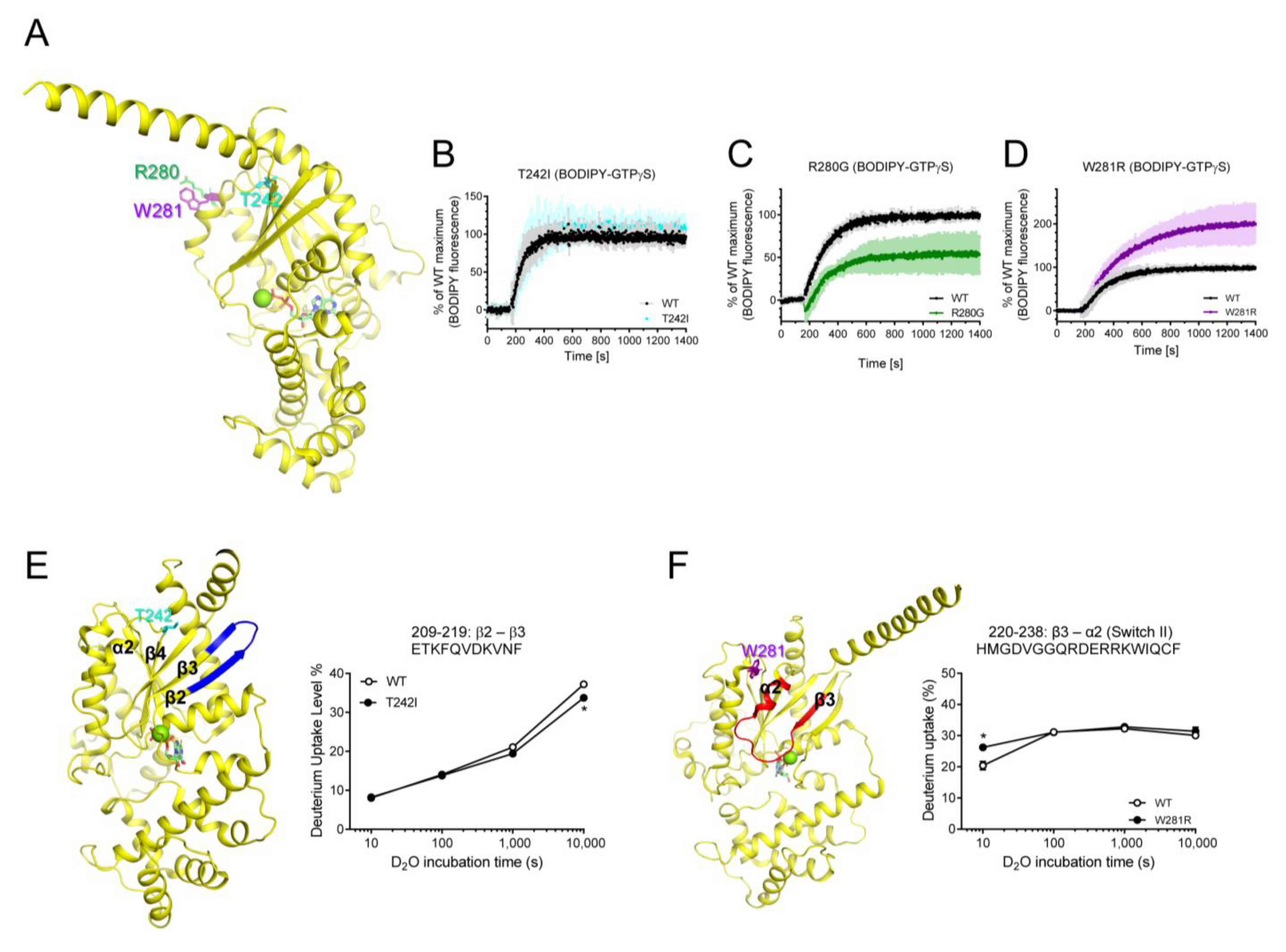Structural and Functional Implication of Natural Variants of Gαs
Abstract
1. Introduction
2. Results
2.1. Gαs Natural Variants That Lead to Aggregation in E. coli Purification System
2.2. Natural Variants in AHD of Gαs
2.3. Gαs Natural Variants within RD
3. Discussion
4. Materials and Methods
4.1. Materials
4.2. Expression and Purification of WT and Mutant Gαs
4.3. HDX-MS Analysis
4.4. BODIPY-GTPγS Assay
4.5. Statistical Analysis
Supplementary Materials
Author Contributions
Funding
Institutional Review Board Statement
Informed Consent Statement
Data Availability Statement
Conflicts of Interest
References
- Milligan, G.; Kostenis, E. Heterotrimeric G-proteins: A short history. Br. J. Pharmacol. 2006, 147 (Suppl. 1), S46–S55. [Google Scholar] [CrossRef] [PubMed]
- Traut, T.W. Physiological concentrations of purines and pyrimidines. Mol. Cell Biochem. 1994, 140, 1–22. [Google Scholar] [CrossRef] [PubMed]
- Northup, J.K.; Sternweis, P.C.; Smigel, M.D.; Schleifer, L.S.; Ross, E.M.; Gilman, A.G. Purification of the regulatory component of adenylate cyclase. Proc. Natl. Acad. Sci. USA 1980, 77, 6516–6520. [Google Scholar] [CrossRef] [PubMed]
- Northup, J.K.; Smigel, M.D.; Gilman, A.G. The guanine nucleotide activating site of the regulatory component of adenylate cyclase. Identification by ligand binding. J. Biol. Chem. 1982, 257, 11416–11423. [Google Scholar] [CrossRef]
- Gilman, A.G. G proteins and dual control of adenylate cyclase. Cell 1984, 36, 577–579. [Google Scholar] [CrossRef]
- Sternweis, P.C.; Smrcka, A.V. Regulation of phospholipase C by G proteins. Trends Biochem. Sci. 1992, 17, 502–506. [Google Scholar] [CrossRef]
- Smrcka, A.V.; Hepler, J.R.; Brown, K.O.; Sternweis, P.C. Regulation of polyphosphoinositide-specific phospholipase C activity by purified Gq. Science 1991, 251, 804–807. [Google Scholar] [CrossRef]
- Taylor, S.J.; Chae, H.Z.; Rhee, S.G.; Exton, J.H. Activation of the beta 1 isozyme of phospholipase C by alpha subunits of the Gq class of G proteins. Nature 1991, 350, 516–518. [Google Scholar] [CrossRef]
- Liu, X.; Xu, X.; Hilger, D.; Aschauer, P.; Tiemann, J.K.S.; Du, Y.; Liu, H.; Hirata, K.; Sun, X.; Guixa-Gonzalez, R.; et al. Structural Insights into the Process of GPCR-G Protein Complex Formation. Cell 2019, 177, 1243–1251.e1212. [Google Scholar] [CrossRef]
- Sunahara, R.K.; Tesmer, J.J.; Gilman, A.G.; Sprang, S.R. Crystal structure of the adenylyl cyclase activator Gsalpha. Science 1997, 278, 1943–1947. [Google Scholar] [CrossRef]
- Wall, M.A.; Coleman, D.E.; Lee, E.; Iniguez-Lluhi, J.A.; Posner, B.A.; Gilman, A.G.; Sprang, S.R. The structure of the G protein heterotrimer Gi alpha 1 beta 1 gamma 2. Cell 1995, 83, 1047–1058. [Google Scholar] [CrossRef]
- Li, J.; Ge, Y.; Huang, J.X.; Stromgaard, K.; Zhang, X.; Xiong, X.F. Heterotrimeric G Proteins as Therapeutic Targets in Drug Discovery. J. Med. Chem. 2020, 63, 5013–5030. [Google Scholar] [CrossRef]
- Syrovatkina, V.; Alegre, K.O.; Dey, R.; Huang, X.Y. Regulation, Signaling, and Physiological Functions of G-Proteins. J. Mol. Biol. 2016, 428, 3850–3868. [Google Scholar] [CrossRef]
- Turan, S.; Bastepe, M. GNAS Spectrum of Disorders. Curr. Osteoporos Rep. 2015, 13, 146–158. [Google Scholar] [CrossRef]
- Juppner, H. Molecular Definition of Pseudohypoparathyroidism Variants. J. Clin. Endocrinol. Metab. 2021, 106, 1541–1552. [Google Scholar] [CrossRef]
- Elli, F.M.; Pereda, A.; Linglart, A.; Perez de Nanclares, G.; Mantovani, G. Parathyroid hormone resistance syndromes—Inactivating PTH/PTHrP signaling disorders (iPPSDs). Best Pract. Res. Clin. Endocrinol. Metab. 2018, 32, 941–954. [Google Scholar] [CrossRef]
- Weinstein, L.S.; Shenker, A.; Gejman, P.V.; Merino, M.J.; Friedman, E.; Spiegel, A.M. Activating mutations of the stimulatory G protein in the McCune-Albright syndrome. N. Engl. J. Med. 1991, 325, 1688–1695. [Google Scholar] [CrossRef]
- Freda, P.U.; Chung, W.K.; Matsuoka, N.; Walsh, J.E.; Kanibir, M.N.; Kleinman, G.; Wang, Y.; Bruce, J.N.; Post, K.D. Analysis of GNAS mutations in 60 growth hormone secreting pituitary tumors: Correlation with clinical and pathological characteristics and surgical outcome based on highly sensitive GH and IGF-I criteria for remission. Pituitary 2007, 10, 275–282. [Google Scholar] [CrossRef]
- Diaz, A.; Danon, M.; Crawford, J. McCune-Albright syndrome and disorders due to activating mutations of GNAS1. J. Pediatr. Endocrinol. Metab. 2007, 20, 853–880. [Google Scholar] [CrossRef]
- Miric, A.; Vechio, J.D.; Levine, M.A. Heterogeneous mutations in the gene encoding the alpha-subunit of the stimulatory G protein of adenylyl cyclase in Albright hereditary osteodystrophy. J. Clin. Endocrinol. Metab. 1993, 76, 1560–1568. [Google Scholar] [CrossRef]
- Riepe, F.G.; Ahrens, W.; Krone, N.; Folster-Holst, R.; Brasch, J.; Sippell, W.G.; Hiort, O.; Partsch, C.J. Early manifestation of calcinosis cutis in pseudohypoparathyroidism type Ia associated with a novel mutation in the GNAS gene. Eur. J. Endocrinol. 2005, 152, 515–519. [Google Scholar] [CrossRef] [PubMed]
- Ahrens, W.; Hiort, O.; Staedt, P.; Kirschner, T.; Marschke, C.; Kruse, K. Analysis of the GNAS1 gene in Albright’s hereditary osteodystrophy. J. Clin. Endocrinol. Metab. 2001, 86, 4630–4634. [Google Scholar] [CrossRef] [PubMed]
- Linglart, A.; Carel, J.C.; Garabedian, M.; Le, T.; Mallet, E.; Kottler, M.L. GNAS1 lesions in pseudohypoparathyroidism Ia and Ic: Genotype phenotype relationship and evidence of the maternal transmission of the hormonal resistance. J. Clin. Endocrinol. Metab. 2002, 87, 189–197. [Google Scholar] [CrossRef] [PubMed]
- Landis, C.A.; Masters, S.B.; Spada, A.; Pace, A.M.; Bourne, H.R.; Vallar, L. GTPase inhibiting mutations activate the alpha chain of Gs and stimulate adenylyl cyclase in human pituitary tumours. Nature 1989, 340, 692–696. [Google Scholar] [CrossRef]
- Riminucci, M.; Fisher, L.W.; Majolagbe, A.; Corsi, A.; Lala, R.; De Sanctis, C.; Robey, P.G.; Bianco, P. A novel GNAS1 mutation, R201G, in McCune-albright syndrome. J. Bone Miner Res. 1999, 14, 1987–1989. [Google Scholar] [CrossRef]
- Schwindinger, W.F.; Francomano, C.A.; Levine, M.A. Identification of a mutation in the gene encoding the alpha subunit of the stimulatory G protein of adenylyl cyclase in McCune-Albright syndrome. Proc. Natl. Acad. Sci. USA 1992, 89, 5152–5156. [Google Scholar] [CrossRef]
- Yang, I.; Park, S.; Ryu, M.; Woo, J.; Kim, S.; Kim, J.; Kim, Y.; Choi, Y. Characteristics of gsp-positive growth hormone-secreting pituitary tumors in Korean acromegalic patients. Eur. J. Endocrinol. 1996, 134, 720–726. [Google Scholar] [CrossRef]
- Gorelov, V.N.; Dumon, K.; Barteneva, N.S.; Palm, D.; Roher, H.D.; Goretzki, P.E. Overexpression of Gs alpha subunit in thyroid tumors bearing a mutated Gs alpha gene. J. Cancer Res. Clin. Oncol. 1995, 121, 219–224. [Google Scholar] [CrossRef]
- Williamson, E.A.; Ince, P.G.; Harrison, D.; Kendall-Taylor, P.; Harris, P.E. G-protein mutations in human pituitary adrenocorticotrophic hormone-secreting adenomas. Eur. J. Clin. Investig. 1995, 25, 128–131. [Google Scholar] [CrossRef]
- Ishikawa, Y.; Tajima, T.; Nakae, J.; Nagashima, T.; Satoh, K.; Okuhara, K.; Fujieda, K. Two mutations of the Gsalpha gene in two Japanese patients with sporadic pseudohypoparathyroidism type Ia. J. Hum. Genet. 2001, 46, 426–430. [Google Scholar] [CrossRef]
- Farfel, Z.; Iiri, T.; Shapira, H.; Roitman, A.; Mouallem, M.; Bourne, H.R. Pseudohypoparathyroidism, a novel mutation in the betagamma-contact region of Gsalpha impairs receptor stimulation. J. Biol. Chem. 1996, 271, 19653–19655. [Google Scholar] [CrossRef]
- Iiri, T.; Farfel, Z.; Bourne, H.R. Conditional activation defect of a human Gsalpha mutant. Proc. Natl. Acad. Sci. USA 1997, 94, 5656–5661. [Google Scholar] [CrossRef]
- Rickard, S.J.; Wilson, L.C. Analysis of GNAS1 and overlapping transcripts identifies the parental origin of mutations in patients with sporadic Albright hereditary osteodystrophy and reveals a model system in which to observe the effects of splicing mutations on translated and untranslated messenger RNA. Am. J. Hum. Genet. 2003, 72, 961–974. [Google Scholar] [CrossRef]
- Warner, D.R.; Gejman, P.V.; Collins, R.M.; Weinstein, L.S. A novel mutation adjacent to the switch III domain of G(S alpha) in a patient with pseudohypoparathyroidism. Mol. Endocrinol. 1997, 11, 1718–1727. [Google Scholar] [CrossRef]
- Warner, D.R.; Weng, G.; Yu, S.; Matalon, R.; Weinstein, L.S. A novel mutation in the switch 3 region of Gsalpha in a patient with Albright hereditary osteodystrophy impairs GDP binding and receptor activation. J. Biol. Chem. 1998, 273, 23976–23983. [Google Scholar] [CrossRef]
- Lim, S.H.; Poh, L.K.; Cowell, C.T.; Tey, B.H.; Loke, K.Y. Mutational analysis of the GNAS1 exons encoding the stimulatory G protein in five patients with pseudohypoparathyroidism type 1a. J. Pediatr. Endocrinol. Metab. 2002, 15, 259–268. [Google Scholar] [CrossRef]
- Chan, I.; Hamada, T.; Hardman, C.; McGrath, J.A.; Child, F.J. Progressive osseous heteroplasia resulting from a new mutation in the GNAS1 gene. Clin. Exp. Dermatol. 2004, 29, 77–80. [Google Scholar] [CrossRef]
- Pohlenz, J.; Ahrens, W.; Hiort, O. A new heterozygous mutation (L338N) in the human Gsalpha (GNAS1) gene as a cause for congenital hypothyroidism in Albright’s hereditary osteodystrophy. Eur. J. Endocrinol. 2003, 148, 463–468. [Google Scholar] [CrossRef]
- Iiri, T.; Herzmark, P.; Nakamoto, J.M.; van Dop, C.; Bourne, H.R. Rapid GDP release from Gs alpha in patients with gain and loss of endocrine function. Nature 1994, 371, 164–168. [Google Scholar] [CrossRef]
- Wu, W.I.; Schwindinger, W.F.; Aparicio, L.F.; Levine, M.A. Selective resistance to parathyroid hormone caused by a novel uncoupling mutation in the carboxyl terminus of G alpha(s). A cause of pseudohypoparathyroidism type Ib. J. Biol. Chem. 2001, 276, 165–171. [Google Scholar] [CrossRef]
- Schwindinger, W.F.; Miric, A.; Zimmerman, D.; Levine, M.A. A novel Gs alpha mutant in a patient with Albright hereditary osteodystrophy uncouples cell surface receptors from adenylyl cyclase. J. Biol. Chem. 1994, 269, 25387–25391. [Google Scholar] [CrossRef]
- Thiele, S.; de Sanctis, L.; Werner, R.; Grotzinger, J.; Aydin, C.; Juppner, H.; Bastepe, M.; Hiort, O. Functional characterization of GNAS mutations found in patients with pseudohypoparathyroidism type Ic defines a new subgroup of pseudohypoparathyroidism affecting selectively Gsalpha-receptor interaction. Hum. Mutat. 2011, 32, 653–660. [Google Scholar] [CrossRef] [PubMed]
- Weinstein, L.S. G(s)alpha mutations in fibrous dysplasia and McCune-Albright syndrome. J. Bone Miner Res. 2006, 21 (Suppl. 2), P120–P124. [Google Scholar] [CrossRef] [PubMed]
- Knight, K.M.; Ghosh, S.; Campbell, S.L.; Lefevre, T.J.; Olsen, R.H.J.; Smrcka, A.V.; Valentin, N.H.; Yin, G.; Vaidehi, N.; Dohlman, H.G. A universal allosteric mechanism for G protein activation. Mol. Cell 2021, 81, 1384–1396.e6. [Google Scholar] [CrossRef] [PubMed]
- Warner, D.R.; Romanowski, R.; Yu, S.; Weinstein, L.S. Mutagenesis of the conserved residue Glu259 of Gsalpha demonstrates the importance of interactions between switches 2 and 3 for activation. J. Biol. Chem. 1999, 274, 4977–4984. [Google Scholar] [CrossRef]
- Jones, J.C.; Duffy, J.W.; Machius, M.; Temple, B.R.; Dohlman, H.G.; Jones, A.M. The crystal structure of a self-activating G protein alpha subunit reveals its distinct mechanism of signal initiation. Sci. Signal. 2011, 4, ra8. [Google Scholar] [CrossRef]
- Jones, J.C.; Jones, A.M.; Temple, B.R.; Dohlman, H.G. Differences in intradomain and interdomain motion confer distinct activation properties to structurally similar Galpha proteins. Proc. Natl. Acad. Sci. USA 2012, 109, 7275–7279. [Google Scholar] [CrossRef]
- Kim, H.R.; Ahn, D.; Jo, J.B.; Chung, K.Y. Effect of alpha-helical domain of Gi/o alpha subunit on GDP/GTP turnover. Biochem. J. 2022, 479, 1843–1855. [Google Scholar] [CrossRef]
- McEwen, D.P.; Gee, K.R.; Kang, H.C.; Neubig, R.R. Fluorescent BODIPY-GTP analogs: Real-time measurement of nucleotide binding to G proteins. Anal. Biochem. 2001, 291, 109–117. [Google Scholar] [CrossRef]
- Konermann, L.; Tong, X.; Pan, Y. Protein structure and dynamics studied by mass spectrometry: H/D exchange, hydroxyl radical labeling, and related approaches. J. Mass Spectrom. 2008, 43, 1021–1036. [Google Scholar] [CrossRef]
- Ham, D.; Ahn, D.; Ashim, J.; Cho, Y.; Kim, H.R.; Yu, W.; Chung, K.Y. Conformational switch that induces GDP release from Gi. J. Struct. Biol. 2021, 213, 107694. [Google Scholar] [CrossRef]





| Natural Variants * | Loss-of-Function | Gain-of-Function | |||||
|---|---|---|---|---|---|---|---|
| AHO a | PHP1A b | PHP1B c | PHP1C d | POH e | MAS f | Tumor | |
| L99P | [20] | ||||||
| I106S | [21] | [21] | |||||
| P115L | [22] | ||||||
| D156N | [23] | ||||||
| V159M | [23] | ||||||
| R165C | [20] | ||||||
| R201C | [17] | [24] | |||||
| R201G | [25] | ||||||
| R201H | [17,26] | [24] | |||||
| R201S | [27] | ||||||
| R201L | [28] | ||||||
| Q227H | [29] | ||||||
| Q227R | [24] | ||||||
| R231H | [30] | [30,31,32] | |||||
| T242I | [33] | ||||||
| F246S | [33] | ||||||
| S250R | [34] | ||||||
| R258W | [35] | ||||||
| E259V | [33] | ||||||
| R280G | [36] | ||||||
| W281R | [37] | ||||||
| K338N | [38] | [38] | |||||
| A366S | [39] | ||||||
| I382del | [40] | ||||||
| R385H | [41] | ||||||
| L388R | [42] | ||||||
| E392K | [42] | ||||||
Disclaimer/Publisher’s Note: The statements, opinions and data contained in all publications are solely those of the individual author(s) and contributor(s) and not of MDPI and/or the editor(s). MDPI and/or the editor(s) disclaim responsibility for any injury to people or property resulting from any ideas, methods, instructions or products referred to in the content. |
© 2023 by the authors. Licensee MDPI, Basel, Switzerland. This article is an open access article distributed under the terms and conditions of the Creative Commons Attribution (CC BY) license (https://creativecommons.org/licenses/by/4.0/).
Share and Cite
Jeong, Y.; Chung, K.Y. Structural and Functional Implication of Natural Variants of Gαs. Int. J. Mol. Sci. 2023, 24, 4064. https://doi.org/10.3390/ijms24044064
Jeong Y, Chung KY. Structural and Functional Implication of Natural Variants of Gαs. International Journal of Molecular Sciences. 2023; 24(4):4064. https://doi.org/10.3390/ijms24044064
Chicago/Turabian StyleJeong, Yejin, and Ka Young Chung. 2023. "Structural and Functional Implication of Natural Variants of Gαs" International Journal of Molecular Sciences 24, no. 4: 4064. https://doi.org/10.3390/ijms24044064
APA StyleJeong, Y., & Chung, K. Y. (2023). Structural and Functional Implication of Natural Variants of Gαs. International Journal of Molecular Sciences, 24(4), 4064. https://doi.org/10.3390/ijms24044064





